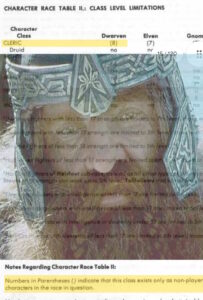 We needed a full roster of the dwarves of Romek Zoden. Fortunately for us, the Monster Manual provides us with some guidance. I’ve already pushed out a YuTuub Short detailing the process, so let me just hit you with the high points.
We needed a full roster of the dwarves of Romek Zoden. Fortunately for us, the Monster Manual provides us with some guidance. I’ve already pushed out a YuTuub Short detailing the process, so let me just hit you with the high points.
The base number of dwarves (4d10 x 10) came up with a nice, round 240 dwarves. With that many of them, we add in a trio of leaders. Chief Uthar Tel Recus (F6) and his lieutenant Urist Volal’Arzes (F4) are the military commanders of the small border fort nestled into the northern slopes of the Bofaheart Mountains. The spiritual needs of the community are met by The Kutamaral (F6/C6).
Six heroic dwarves (fighters of level 2 through 6) are regularly sent out on patrol to the north, east, and west, with occasional forays over Deeznuts Pass to raid the Ligmatic Cloister. These levelled dwarves lead patrols of two to thirteen “normal men” style dwarves, and it is these patrols that the human PCs are most likely to encounter now that we’ve pulled the first dwarven patrol into the ranks of PCdom.
There is a 60% chance animals guard the fort, but that came up with zilch.
So let’s go back to how to track and adjudicate this.
I’ve got a one-pager that lists the leaders and their normal load-outs. When the PCs encounter dwarves, I’ll roll a d6 to determine what level the leader of the patrol is:
- F6 carries a sword and spear
- F5 carries an axe and hammer
- F4 carries a hammer and pick
- F3 carries an axe and mace
- F2 carries a sword and spear
- F2 carries a hammer and pick
When a dwarf patrol is encountered, it will consist of one of those six plus 1d8+1 melee dwarves armed with the same kit. Add to that 1d4 dwarves with picks and light crossbows for artillery support, and you’ve got yourself a tough little squad of stunties.
And what about Sorin, Gimmi, Kili, and their NPC cleric? They run around with four spear-toting grunts, so we’ll back eight dwarves off the total. Since half this squad is levelled, we can treat them as a “special ops” squad. They go out and do pretty much as they please, provided they serve the needs of Romek Zoden in its quest to strip-mine the Cloister Dungeon of anything lucrative that isn’t nailed down and they’ve got hammers for anything that is. They also want to whittle down the number of orcs in that dungeon to keep it from becoming a threat to themselves. For that reason, they are likely to leave human PC parties alone.

As for the larder, these dwarves don’t have much. The few hits they got on the treasure table came up with bare minimums. To you and me 12,000gp, 100pp, 16 gems, and four magic items might seem like a lot, but to 240 dwarves that is a pittance and helps explain why they are out here. They are looking to score more gold the old fashioned way – loot it. The magic items in the hoard are there for a reason known only to the dwarves. Until an enemy seeks out and finds the hoard, they remain under lock and key. When our troubleshooters deliver a ten-percent tithe to their liege, that gold will be added to the total in the treasure room and just like that our world begins to grow and breathe and the things we do have real consequences. Crazy, right?
And just like that the faceless dwarves on the wandering monster table have personalities, goals, and motivations. We have a second faction on the map, and one well-suited to explore a certain treasure buried at the heart of a crater over in The Dark Woods – if they should learn of it.
And herein lies the real lesson. This is how you can slowly, incrementally, and organically build a D&D campaign setting that appeals to you and your players. You start with a blank slate and let the dice give you the broad and general outlines. When something vaguely interesting shows up – a castle ruin or an odd depression, or a swamp where one shouldn’t be – you can poke it with the Interesting Stick and see what shakes out. Over time, your world will accrete these little points of interest, and before you know it both you and your players will start finding connections and stories that link them together. You can sprinkle in factions and mysteries at a rate that you find comfortable, and because it happened at your pace and by your dice, you won’t have nearly as much trouble remembering the little details. That little detail won’t be just a paragraph on page 38 of a module you half-read once a few weeks ago. Instead, it’ll be that surprising roll that made you scratch your head, and that you thought about in the shower and while driving and when you should have been working, before finally settling on an answer that appeals to you.
You might even build yourself a little mystery – a list of possibilities that must remain unresolved until the moment of actual interaction.
In the case of Romek Zoden, I’ve got the mystery of what the border fort even looks like. When playing the Dwarf Patrol, we don’t need to concern ourselves with such niceties as floorplans any more than we need a map of the human village of Corvusburg. It might be carved into a mountainside. It might be a stone fortress perched on a cliff. It might be a hole in the ground, hidden and disguised by a natural rockfall. When we need a list of definites, we’ll build a table of results. When we need to lock it down once and for all, we’ll roll on the table. Until then, we have a wonderful little known-unknown. Something that we know is there, that we can see the vague borders of, but that still teases us with the promise of even greater adventure.

